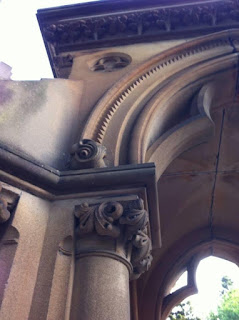In 1792,
Governor Arthur Phillip Proclaimed The Open Space Which Became The Botanical
Gardens, Domain, Hyde Park, And Macquarie Street For Government Use.
The Street Itself Was Proclaimed In
1810 By Governor Lachlan Macquarie. At First It Only Ran From Hyde Park To Bent
Street, But In 1845 it was Extended In Both Directions.
CENTRE OF SOCIETY
–
CENTRE OF
MEDICINE – Being Macquarie Street Specialist Became A Prestigious Title
CENTRE OF
CEREMONY - Ceremonial=al Tradition Began With The Waterloo Ball Of 1816
(Commemorating Wellington’s Victory Seven Months Late As The Colony Had Only
Just Received The News)
1 Hyde Park –
Part Of Governor Phillip’s 1792 Common, Renamed Hyde Park By Governor
Macquarie. The Archibald Fountain Was Added In The 1920’a
2. Queens Square
– The Centerpiece Of The Macquarie Town Plan Prince Albert’s Statue Arrived In
1866
3. Hyde Park
Barracks – It Housed Convict Gangs Overnight. Above The Entrance Is The Oldest
Clock In Australia. The Barracks Survived Several Plans For Demolition
4. The Mint –
Completed in 1816 – As Part Of the Rum Hospital. Restored In the 1970’s
5. Sydney
Hospital –
Known As the Rum Hospital. The Builders Were Paid With 3
Years/45,000 Gallons Of Rum. I
I Have Read That Francis Greenway i
Didn't Actually Design "THE RUM HOSPITAL"
And That In Actual Fact It Was Lady Macquarie Behind The Design Of The Original Building. In 1810 - 1815 Lady Macquarie And Elizabeth MacArthur Were About The Only Two Ladies That Would've Been Fully Literate In The New Colony.
One Of The Main Reasons It Would Not Have Been Public Knowledge That Lady Macquarie Designed The Rum Hospital Building Was Tjat It Was Unacceptable For A Female To Do That Sort Of Thing.
6. Martin Place –
Named After the 19th Century Premier Sir James MARTIN. Most
Significant Is The Reserve Bank And Museum If Australian Currency
7. St Stephen’s
Church –
8. Parliament
House –
9. The State
Library –
10. Wyoming – One
Of The Sky Scrapers Of Macquarie Street In 1909, It Was Designed By W. Burcham
Clamp -
11. Horbury House
– These Are Two Survivors Of A Terrace Of Seven Built In 1845 As Gentleman’s’
Residences. Early Occupants Include Robert Lowe (Later Viscount Sherbrooke),
Conrad Martens
12. The Royal
Botanical Gardens – The First Farm Was Started Here. Later, Governor Bligh’s
Daughter, Mary, Had More Success With Gardening. The Initial Collection Was
Restricted But The Enlarged Gardens Were Opened To The Public In 1831, And The
Basis Of The Present Gardens Established By Charles Moore From 1848 – 1896. The
Garden Palace Was In These Grounds.
-
13. The Royal
College Of Physicians – No 145 Was The Home Of John Fairfax.
14. BMA House –
The British Medical Association House Was Built In 1929, as Medical Chambers With
A Lecture Hall On The Ground Floor.
15. History House
(Royal Australian Historical Society) - Another Remnant Of A Gentleman’s
Residency. This Was By Architect George Mansfield Housed The 1870’s Reform
Club. As The Middle Classes Moved Away From The City It Became A Boarding House
And Then Homes And Rooms of Medical Practitioners And Acquired By The RAHS in
1969
16. The Astor –
in 1914 John O’Brien Built The Exclusive 13 Storey Astor Apartments Designed
With A Basement Restaurant Linked By Service Lifts To Each Apartment, Enabling
Dinner Deliveries To Residents. The roof Garden Included A Glasshouse, Fernery
And Dance Floor.
17. Chief
Secretary’s Building – The Fine Interior Of This French Second Empire Style
Government Office Designed By Architect James Barnet .
18. Treasury
Building – Now Included In The Intercontinental Hotel This Was Built IN two
stages, Beginning With Te Treasury (The Bridge Street Corner) In 1849 In a
Classical Revival Style And Bridge Street By W L Vernon To Include The Premier’s
Officer
19.
Conservatorium Of Music – Beyond The Equestrian statue Of Edward VII This
Stable Could Accommodate 30 Horses Plus Servants
20. Government
House – Beyond The Gatehouse And Down the Roadway To The North Of The Former
Stables In The Gothic Castle Style Government House. Still Used By The State
Governor. The house Is Open To Te Public on Certain Days Designed In England By
Edward Blore And Constructed Under Mortimer Lewis’s Supervision 1837-45
21. Transport
House (1938) and Sir Stamford Hotel (1896)
22. Royal
Automobile Club
23. Bennelong
Point -
QUOTE
1857 - by John Askew
"Tiers Of Fine Buildings Seem To Rise Once Above The Other, Like The Seats In An Amphitheatre, And Towering Above Them All Is The Tall Spire Of St James Church"
1857 - by John Askew
"The Best Thing In This Neighbourhoods In All It's Glory Is On A Summer's Evening, About An Hour After Sunset, When The Drawing Rooms Are In A Blaze Of Light. Then The Rich Tones Of A Piano Or Some Other Musical Instrument Are Heard Gushing Fourth From The Open Windows, Accompanied By The Sweet Melody Of Female Voices. Beautiful Ladies, Dressed In White May Be Seen Sitting Upon The Verandahs, or Lounging On Magnificent Couches, Partially Concealed By The Folds Of Rich Crimson Curtains."






























